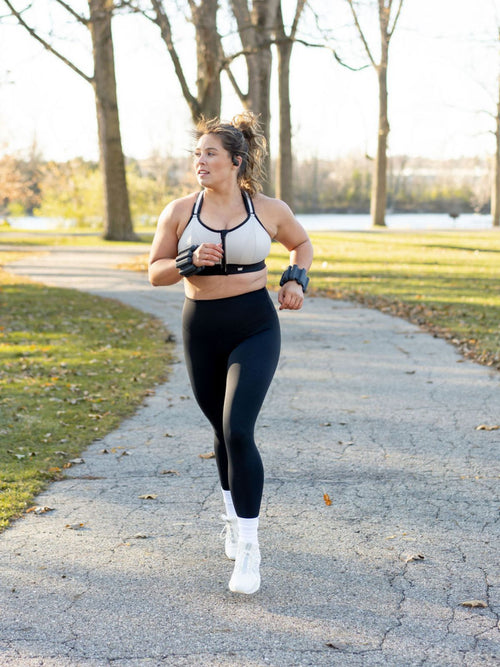Free shipping on U.S. orders over $99 Shop Now
How Can A Woman Get A Defined Chest?
If you're looking for ways to get a more defined chest, lifting weights and doing cardio will get the job done. It sounds simple enough, but the details and follow-through are where things get far more difficult. So for any lady out there looking for guidance, here's what you need to know about getting a more defined chest through exercise.
Women can build a more defined chest by increasing muscle growth and decreasing body fat. An effective way to achieve this is through resistance exercises and high-intensity interval training. Each approach will stimulate the strength, definition, and visibility of chest muscles.
With the right amount of dedication and motivation, any woman can make her chest more defined with a focused high-intensity interval training (HIIT) program. This article will give you a blueprint to combine strength training and cardio to make your chest muscles more defined.
Before you head off to the gym or grab your free weights, let's go over some of the basics of HIIT.
How Many Times A Week Should A Woman Do HIIT?
By definition, HIIT workouts are intense. When done properly, they should make you pretty tired. If done properly, you may not want to do more than one a week. Unfortunately, you might have to do just that to see results.
Women should do HIIT three times per week. A study from the International Journal of Sports Medicine found that women who did two HIIT workouts per week improved their fitness levels, but women who did three HIIT workouts per week improved their fitness and substantially lowered their body fat.
In other words, if you're fitness levels can handle it, 3 HIIT workouts per week is ideal.
Research Proves That 3 Is The Magic Number for HIIT
The study reported in the International Journal of Sports Medicine set out to find the ideal number of HIIT workouts per week it would take to make noticeable changes.
They measured several things, including cardiovascular fitness and waist circumference. Subjects in the study did intense cycling workouts either two or three times per week.
The researchers found that two HIIT sessions per week were enough to make people more fit, but they didn’t burn a substantial amount of fat. Only the three workouts per week group saw a meaningful change in their body fat.
How Does This Apply To A More Defined Chest?
If you want a more defined chest, you have to build muscle and burn fat. You should use HIIT-style training for fat loss, but it might take three workouts per week to get the results you want.
Keep in mind that you might need to train less or more, depending on your fitness level. People who are new to HIIT training can start with two days per week to see how they feel. Those who have been training for a while and are used to intense workouts can do more than three HIIT sessions per week.
The good news is that it’s easier to match the intensity and frequency of HIIT workouts to your individual fitness level, rather than following a standard program. That doesn't make it an easier workout in general, quite the contrary.
It will be an extremely challenging workout, but it will be one that you can customize to where your body is at without compromising the quality of the workout.
If you have no idea where to start, try two workouts per week, then see how your body responds and adjust accordingly.
While you might want to hit the gym every day to work on more defined chest muscles, that's most likely not the best way to get the results your after.
Plan Your Week Around Sets and Reps, Not Days
The ideal number of workouts per week depends on quite a few factors, but one of them is not the number of days that you hit the gym, in fact, it might be better to let go of the notion that there’s a perfect number of workouts per week.
A compilation of studies that examined the ideal weight training workouts for muscle growth in women found that the total number of workouts per week didn't impact muscle gains, but the total amount of training done each week does matter. Meaning cumulative sets and reps have more bearing than days at the gym.
In other words, you could do one or two intense chest workouts in a week. Or, you can do three or four smaller chest workouts spread out over the week. Either way, as long as you do the same number of reps and sets for each exercise, your results should be the same.
And this isn't just one result from one study. This research was built from 15 studies, and there are even outside studies that come to the same conclusions.
One such study in agreement, published in Frontiers in Physiology, even states that more sets per exercise are better for muscle growth, but you should be careful not to overdo it.
If you’re getting injured or are exhausted from training, you need to reduce the number of sets per week.
How Many Times A Week Should A Beginner Be Hitting Chest?
Since sets and reps are a better measure of muscle growth, for beginners it's best to start with two or three sets per chest exercise per week and progress from there. While there’s no definitive recommendation for weekly chest workouts this is a safe entry point to test whether to increase or decrease.
This should be liberating because it means your training can be more flexible. If you can only get to the gym twice per week, you can still do enough to make your chest more defined. If you’d rather space things out, you can do that as well.
Wondering How To Get Started With Your HIIT Chest Workout?
If you're wondering what your HIIT chest workout should look like, then look no further. SHEFIT's created an incredible plan for you that includes 5 supersets, and a visual guide to walk you through every step of the way.
If you want to try to ease into HIIT there are some other options you can consider as well.
The Best of Both Worlds - HIFT
If you’re looking to save time or add some spice to your workouts, you could try high-intensity functional training (HIFT). A great example of HIFT is CrossFit, which crosses traditional weight training exercises with cardio.
If you do a HIFT workout, you don’t need to choose between lifting weights and doing cardio, you can do both in a circuit workout. For example, you could combine push-ups with sprints on the treadmill, and bench press with sprints on a bike.
This style of training is so powerful that you can get the same or similar results as doing each type of workout separately. HIFT increases your cardiovascular fitness as much as HIIT and builds muscle as much as strength training.
Another benefit of HIFT is that you don’t need much time to rest during your workouts. If you’re doing push-ups and sprints on a treadmill you’d only need 10 to 60 seconds to transition between each exercise. That’s because they work different parts of your body.
So you can recover from the treadmill while you do push-ups and vice versa.
Is 20 Minutes of HIIT Effective For A Defined Chest?
20 minutes of HIIT is a sufficient amount of time to be effective, so long as it's performed at the right intensity. One of the benefits of HIIT training is that it takes less time than continuous training (jogging, cycling, etc), but produces similar or better results. For best results, balance intense activity and rest.
When you do endurance training, there’s no rest, but with HIIT workouts you’ll often rest more than you work. It might feel strange to do so, and you might think you're not working hard enough, but that's the nature of HIIT.
The intensity is reinforced and maintained by rounds of rest.
How Much Rest Should You Have In HIIT?
The American College of Sports Medicine recommends 1:1 work-to-rest ratio, where your vigorous activity is matched by the duration of rest. For example, you’d run around a track for 2 minutes at a fast pace. Then, you’d rest for 2 minutes. You could repeat that workout for 20 minutes.
Another form of HIIT is sprint interval training, which involves much shorter and more intense periods of work followed by lengthy rests.
To do a sprint HIIT workout, you could sprint at your fastest pace for 30 seconds, followed by a 4.5-minute recovery. If you repeat that 4 times, you’ve completed a 20-minute HIIT workout.
Sprint interval training is just as effective or even more so than regular HIIT training. In a group of women studied on the subject, participants who did 23-minute sprint workouts burned more fat than women who did 33-minute HIIT workouts.
Getting a More Defined Chest With Weights and Cardio
To get more definition in your chest there are two different styles of training that you should use. The first is traditional strength training which uses weights to build muscle and strength. The second is high-intensity interval training, which burns fat.
You can also do high-intensity functional training, which is a combination of each style of training. Doing so will save you time and produce similar results, although it can be exhausting.
Take note of the number of chest exercises you do over a week, and slowly increase that number. By doing more sets and reps you’ll build chest muscle over time and begin to see greater definition.
For HIIT chest training, pick a work-to-rest ratio that works for you and continue to make your workouts more intense to achieve greater results, and of course, start with SHEFIT's HIIT chest workout.

























